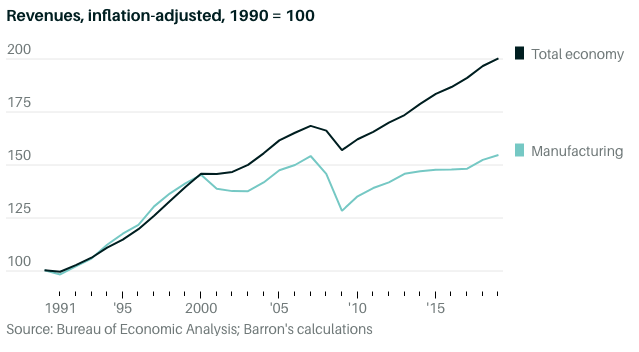Reviving American Manufacturing: Can We Bring Back Factory Jobs?

Table of Contents
The Challenges Facing American Manufacturing
The resurgence of American manufacturing faces significant hurdles. These challenges are multifaceted and require a comprehensive approach to overcome.
Global Competition and Automation
American manufacturers contend with intense global competition, particularly from countries with significantly lower labor costs. Countries like China, Vietnam, and Bangladesh offer manufacturing services at a fraction of the cost, making it difficult for American companies to compete on price alone. Furthermore, the rapid advancement of automation technologies, including robots and artificial intelligence (AI), has led to job displacement in many sectors.
- Examples of countries with lower labor costs: China, Vietnam, Bangladesh, India, Mexico.
- Automation technologies impacting jobs: Robotic process automation (RPA), AI-powered quality control, automated assembly lines.
- The shift towards global supply chains: Many American companies have outsourced manufacturing to overseas facilities, creating complex and often vulnerable global supply chains.
Infrastructure and Supply Chain Issues
America's aging infrastructure poses another significant challenge. Inadequate transportation networks, including roads, railways, and ports, increase transportation costs and lead to delays. This inefficiency directly impacts manufacturing competitiveness. Furthermore, recent global events have highlighted vulnerabilities in global supply chains, emphasizing the need for a more robust and resilient domestic system.
- Inadequate transportation networks: Congested ports, aging highways, insufficient rail capacity.
- Aging infrastructure: Outdated factories, limited access to high-speed internet in some manufacturing regions.
- Supply chain disruptions and vulnerabilities: The COVID-19 pandemic exposed the fragility of global supply chains, leading to shortages and delays.
Skills Gap and Workforce Development
A critical challenge is the skills gap within the American manufacturing workforce. Many manufacturing jobs now require advanced technical skills in areas like robotics, automation, and data analytics. The lack of skilled labor hinders the ability of companies to adopt new technologies and increase productivity.
- Need for skilled workers in advanced manufacturing: Programmers, robotics technicians, data analysts, engineers.
- Apprenticeship programs: Expanding apprenticeship programs to train a new generation of skilled workers.
- Vocational training initiatives: Investing in vocational schools and training programs to develop the necessary skills.
- STEM education: Promoting STEM (Science, Technology, Engineering, and Mathematics) education from an early age.
Strategies for Reviving American Manufacturing
Overcoming these challenges requires a multi-pronged approach focused on strategic initiatives and policy changes.
Reshoring and Onshoring Initiatives
Government policies play a crucial role in encouraging companies to bring manufacturing back to the US (reshoring) or keep it here in the first place (onshoring). Incentives such as tax breaks, subsidies, and targeted investments in infrastructure can make American manufacturing more competitive. Strategic use of tariffs can also protect domestic industries from unfair foreign competition.
- Tax breaks: Offering tax incentives for companies that invest in domestic manufacturing.
- Subsidies: Providing financial support for companies to upgrade their facilities and adopt new technologies.
- Tariffs: Imposing tariffs on imported goods to protect domestic industries.
- Investment in infrastructure: Modernizing transportation networks and improving access to high-speed internet.
Investing in Technology and Innovation
Investing in technological advancements is essential for boosting American manufacturing competitiveness. This includes investing in research and development (R&D), adopting Industry 4.0 technologies (Internet of Things, AI, robotics), and fostering innovation in manufacturing processes. Embracing automation can increase efficiency and productivity while creating new high-skilled jobs.
- Investment in R&D: Funding research into new manufacturing technologies and processes.
- Adoption of Industry 4.0 technologies: Implementing smart factories, using data analytics to optimize production.
- Fostering innovation in manufacturing processes: Supporting startups and entrepreneurs developing new manufacturing technologies.
Supporting Small and Medium-Sized Manufacturers (SMMs)
Small and medium-sized manufacturers (SMMs) form the backbone of American manufacturing. Providing these businesses with access to capital, mentorship programs, government support, and streamlined regulations is crucial for their success and the overall health of the sector.
- Access to capital: Making it easier for SMMs to obtain loans and investments.
- Mentorship programs: Connecting SMMs with experienced business advisors.
- Government support: Providing grants and other forms of financial assistance.
- Streamlining regulations: Reducing bureaucratic hurdles and simplifying regulatory processes.
The Future of American Manufacturing and Factory Jobs
Despite the challenges, the future of American manufacturing holds significant potential for growth and job creation.
Potential for Growth and Job Creation
Specific manufacturing sectors, such as green energy and advanced materials, are poised for significant growth. Strategic regional economic development initiatives and the fostering of manufacturing clusters can concentrate resources and expertise, leading to increased job creation and economic growth.
- Growth sectors: Green energy technologies, advanced materials, medical devices, aerospace.
- Regional economic development strategies: Investing in infrastructure and workforce development in specific regions.
- Cluster development: Creating hubs of related businesses and institutions to foster collaboration and innovation.
The Role of Education and Training
Investing in education and training is paramount to equipping the workforce with the skills needed for the future of manufacturing. Partnerships between educational institutions and industry are essential to create relevant curricula and ensure that graduates possess the skills employers demand.
- Partnerships between educational institutions and industry: Developing apprenticeship programs and internship opportunities.
- Lifelong learning initiatives: Providing opportunities for workers to upgrade their skills throughout their careers.
- Emphasis on STEM education: Promoting STEM education from an early age to create a pipeline of skilled workers.
Conclusion
Reviving American manufacturing and bringing back factory jobs is a complex undertaking that requires addressing multiple interconnected challenges. However, by implementing the strategies outlined above – focusing on reshoring initiatives, investing in technology and innovation, supporting SMMs, and bolstering workforce development – we can create a more competitive and resilient manufacturing sector. The potential benefits for the American economy, including job creation, increased economic growth, and enhanced national security, are substantial. Learn more about how you can support the growth of American-made products and contribute to the resurgence of domestic manufacturing. Let's work together to resurrect factory jobs and ensure a vibrant future for American manufacturing.

Featured Posts
-
 Grandma Chic Style Suki Waterhouses Valentino Ensemble
May 20, 2025
Grandma Chic Style Suki Waterhouses Valentino Ensemble
May 20, 2025 -
 Man Utd Close To Signing World Class Striker Agents Arrival Fuels Speculation
May 20, 2025
Man Utd Close To Signing World Class Striker Agents Arrival Fuels Speculation
May 20, 2025 -
 Hamilton Leclerc Incident Dominates Early Stages Of Chinese Gp
May 20, 2025
Hamilton Leclerc Incident Dominates Early Stages Of Chinese Gp
May 20, 2025 -
 Agatha Christies Endless Night Bbc Announces New Tv Adaptation
May 20, 2025
Agatha Christies Endless Night Bbc Announces New Tv Adaptation
May 20, 2025 -
 Escola Na Tijuca Em Chamas Pais E Ex Alunos Em Estado De Choque
May 20, 2025
Escola Na Tijuca Em Chamas Pais E Ex Alunos Em Estado De Choque
May 20, 2025
Latest Posts
-
 Wayne Gretzkys Fast Facts A Quick Look At The Great Ones Life And Career
May 20, 2025
Wayne Gretzkys Fast Facts A Quick Look At The Great Ones Life And Career
May 20, 2025 -
 Trump Tariffs And Statehood The Unlikely Debate Sparked By Wayne Gretzkys Canadian Patriotism
May 20, 2025
Trump Tariffs And Statehood The Unlikely Debate Sparked By Wayne Gretzkys Canadian Patriotism
May 20, 2025 -
 Paulina Gretzkys Husband A Rare Public Outing
May 20, 2025
Paulina Gretzkys Husband A Rare Public Outing
May 20, 2025 -
 Wayne Gretzky And The Canada Us Relationship Examining The Impact Of Trumps Policies
May 20, 2025
Wayne Gretzky And The Canada Us Relationship Examining The Impact Of Trumps Policies
May 20, 2025 -
 Rare Sighting Paulina Gretzky And Husband Step Out
May 20, 2025
Rare Sighting Paulina Gretzky And Husband Step Out
May 20, 2025
